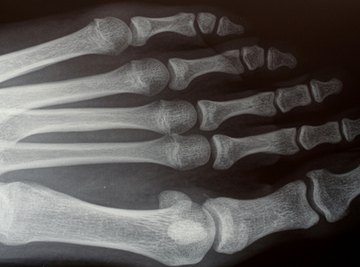
Electromagnetic radiation, found in a wide range of wavelengths and frequencies in the electromagnetic spectrum, includes visible light, radio, television signals, microwaves and X-rays. Generally, radiation with wavelengths much shorter than visible light have enough energy to strip electrons from atoms. Scientists call this ionizing radiation. In general, the shorter the wavelength, the greater the danger to living things. Although longer wavelengths also have their hazards, very short wavelengths, such as X-rays and gamma rays, can easily damage living tissue.
TL;DR (Too Long; Didn't Read)
The most dangerous frequencies of electromagnetic energy are X-rays, gamma rays, ultraviolet light and microwaves. X-rays, gamma rays and UV light can damage living tissues, and microwaves can cook them.
The Power of X-Rays
X-rays have wavelengths ranging from .001 to 10 nanometers, or billionths of a meter. These waves are smaller than an atom and can pass through most materials as sunlight passes through glass. Although X-rays have many beneficial applications, using them requires caution since exposure can cause blindness, cancer and other injuries. X-rays once had novelty uses, such as the shoe-store gadgets that let you see your foot inside a shoe to judge how well it fits. These devices have long since been outlawed. Today, states require licenses to operate X-ray devices.
Ultraviolet Light
Ultraviolet, or UV, light gets its name from the fact that its wavelengths are shorter than violet visible light. Its wavelengths lie in the range of 10 to 350 nanometers and come in several bands, such as UVA and UVB. The sunlight that reaches the Earth’s surface has naturally-occurring amounts of UV. Too much can cause sunburn, skin cancer, and retinal damage. Hospitals use shorter-wavelength UV to kill germs in the air, and sewer treatment plants use it to kill bacteria in liquid waste. Light from a germicidal UV lamp can cause blindness if you look directly at it. Because it has longer wavelengths than X-rays, UV causes less damage to tissue, but even so, it is still not completely safe.
Gamma Rays
Beyond X-rays are even shorter wavelengths called gamma rays. Nuclear processes in atoms produce this kind of radiation, which has more energy and greater penetrating power than X-rays. Food producers use gamma ray devices to kill mold, germs, and parasites in fruits and vegetables. People can work with gamma radiation only behind thick lead shielding.
Microwaves Excite Molecules
Although microwaves have wavelengths too long to be ionizing, the power in microwaves can make them dangerous. Microwaves have wavelengths between .01 and 5 centimeters, much longer than those of visible light. They produce heat by causing certain molecules, like water, to vibrate strongly. Cell phones and other gadgets emit microwaves although they are generally considered too weak to affect living tissue. Your microwave oven, on the other hand, can produce more than 1,000 watts of microwaves and cause serious harm. Fortunately, microwaves are easily shielded.
References
About the Author
Chicago native John Papiewski has a physics degree and has been writing since 1991. He has contributed to "Foresight Update," a nanotechnology newsletter from the Foresight Institute. He also contributed to the book, "Nanotechnology: Molecular Speculations on Global Abundance." Please, no workplace calls/emails!
Photo Credits
x-ray image by Claudio Calcagno from Fotolia.com
